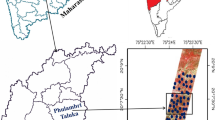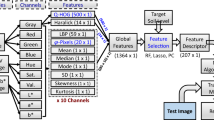Abstract
Computer vision and its technologies are being used in the area of agricultural automation to identify, locate, and track targets for further image processing. Mostly, agricultural production has been highly dependent on natural resources like soil, water, and other related natural minerals from the soil. Soil classification is a way of arranging soils that have similar characteristics into groups. Identifying and classifying soils has a great role to play in agricultural productivity as it helps to provide relevant information which aids agricultural experts to recommend the type of crop best suited for a specific type of soil. This study mainly concentrated on classifying soil types such as clay soil, loam soil, sandy soil, peat soil, silt soil, and chalk soil. The soil images were collected from Amhara region at different locations by using a sony digital camera. To reduce image noise due to handshake we used a camera stand or arm to avoid other types of noises like environmental lighting effects and shadow. Once the dataset was collected, preprocessing such as resizing and gamma correction was performed to remove noise from the images, and contrast adjustment was also performed. Experimental research was applied as a general methodology and the experiment was conducted based on two approaches. The first approach used CNN as an end-to-end classifier and the second used a hybrid approach which used CNN as a feature extractor and SVM as a classifier. When CNN was used as an end-to-end classifier, a classification accuracy of 88% was achieved, whereas when the hybrid approach which used CNN as feature extractor and SVM as classifier was employed, a classification accuracy of 95% was achieved. Finally, we conclude that the hybrid approach is better than that of the End-to-End classification using our proposed model.







Similar content being viewed by others
Data availability
Not applicable.
Code availability
Not applicable.
Change history
05 October 2023
A Correction to this paper has been published: https://doi.org/10.1007/s11042-023-17310-9
References
Albawi S, Mohammed TA (2018) Understanding of a convolutional neural network, no. April 2017. https://doi.org/10.1109/ICEngTechnol.2017.8308186
Archana Reddy AKM et al (2020) Soil classification and crop suggestion using machine learning. Int J Res Appl Sci Eng Technol 8(7):1625–1628. https://doi.org/10.22214/ijraset.2020.30611
Barman U, Choudhury RD (2020) Soil texture classification using multi class support vector machine. Inf Process Agric 7(2):318–332. https://doi.org/10.1016/j.inpa.2019.08.001
Bhargavi P, Jyothi S (2010) Soil classification using GATREE. Int J Comput Sci Inf Technol 2(5):184–191. https://doi.org/10.5121/ijcsit.2010.2514
Gao X, Lu T, Liu P, Lu Q (2014) A soil moisture classification model based on SVM used in agricultural WSN. 2014 IEEE 7th Jt Int Inf Technol Artif Intell Conf ITAIC 2014 432–436. https://doi.org/10.1109/ITAIC.2014.7065086
Getahun M (2015) Characterisation of agricultural soils in Cascape intervention woredas of Amhara Region, p 172. Online Available at: https://edepot.wur.nl/481237
Harlianto PA, Adji TB, Setiawan NA (2017) Comparison of machine learning algorithms for soil type classification. Proceeding – 2017 3rd Int. Conf. Sci. Technol. ICST 2017, pp 7–10. https://doi.org/10.1109/ICSTC.2017.8011843
Mengistu AD, Alemayehu DM (2018) Soil characterization and classification: a hybrid approach of computer vision and sensor network. Int J Electr Comput Eng 8(2):989–995. https://doi.org/10.11591/ijece.v8i2.pp989-995
Mesfin K, Tesfaye S, Girma K, Dejene A, Tsegaye G (2017) Description, characterization and classification of the major soils in Jinka Agricultural Research Center, South Western Ethiopia. J Soil Sci Environ Manag 8(3):61–69. https://doi.org/10.5897/jssem2015.0498
Mitra KC, Islam SMM (2018) Soil classification using machine learning methods and crop suggestion based on soil series, no. December 2020. https://doi.org/10.1109/ICCITECHN.2018.8631943
Nikiforova AA (2019) Performance of SVM classifier for image based soil classification. IEEE 46(6):467–488. https://doi.org/10.5771/0943-7444-2019-6-467
Salau AO, Jain S (2019) Feature extraction: a survey of the types, techniques, and applications. In: 5th IEEE International Conference on Signal Processing and Communication (ICSC), Noida, pp 158–164. https://doi.org/10.1109/ICSC45622.2019.8938371
Satalino G, Panciera R, Balenzano A, Mattia F, Walker J (2012) COSMO-SkyMed multi-temporal data for land cover classification and soil moisture retrieval over an agricultural site in Southern Australia. IEEE 15701–5704. https://doi.org/10.1109/IGARSS.2012.6352317
Xie H et al (2015) Soil type recognition as improved by genetic algorithm-based variable selection using near infrared spectroscopy and partial least squares discriminant analysis. Sci Rep 5(April):1–10. https://doi.org/10.1038/srep10930
Zebire DA, Ayele T, Ayana M (2019) Characterizing soils and the enduring nature of land uses around the Lake Chamo Basin in South-West Ethiopia. J Ecol Environ 43(1):1–32. https://doi.org/10.1186/s41610-019-0104-9
Author information
Authors and Affiliations
Corresponding author
Ethics declarations
Competing interests
The authors declare that they have no competing interests.
Conflict of interest
The authors declare that they have no conflict of interest.
Additional information
Publisher’s note
Springer Nature remains neutral with regard to jurisdictional claims in published maps and institutional affiliations.
The original online version of this article was revised: There was a typographical error in the author’s name “Ayodeji Olalekan Salau” in the original publication of this article .
Rights and permissions
Springer Nature or its licensor (e.g. a society or other partner) holds exclusive rights to this article under a publishing agreement with the author(s) or other rightsholder(s); author self-archiving of the accepted manuscript version of this article is solely governed by the terms of such publishing agreement and applicable law.
About this article
Cite this article
Abeje, B.T., Salau, A.O., Gela, B.M. et al. Soil type identification model using a hybrid computer vision and machine learning approach. Multimed Tools Appl 83, 575–589 (2024). https://doi.org/10.1007/s11042-023-15692-4
Received:
Revised:
Accepted:
Published:
Issue Date:
DOI: https://doi.org/10.1007/s11042-023-15692-4




